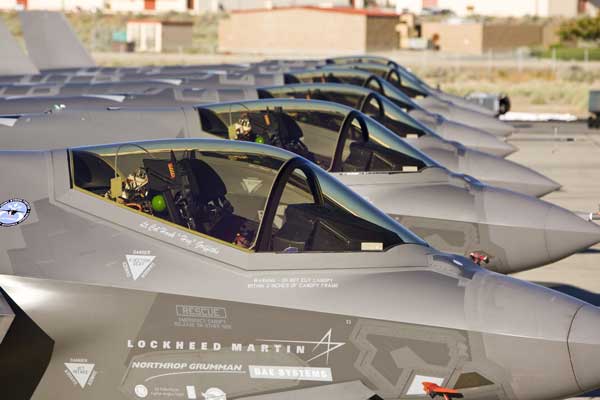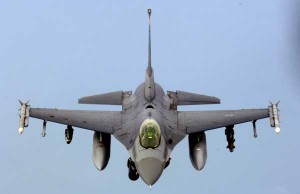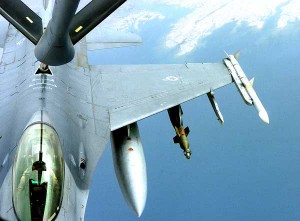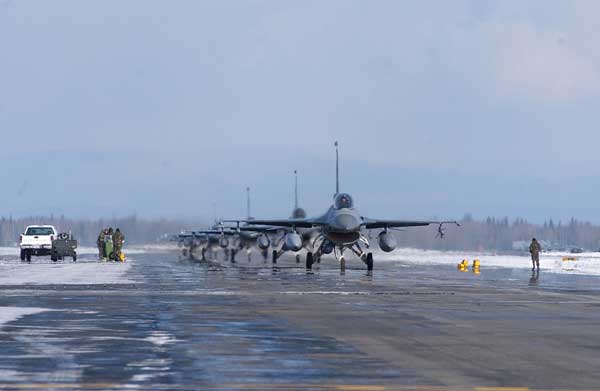An Interview with Joel Malone
 F-35As at Edwards AFB June 2011 (Credit: Lockheed Martin)
F-35As at Edwards AFB June 2011 (Credit: Lockheed Martin)
07/25/2011 – The shift from the F-16 to the F-35A for the USAF will provide significant capability to improve operational performance and operational tempo. In an interview with Joel Malone, the shift was discussed and analyzed.
Joel Malone has extensive USAF operational experience. He retired in August 2008 from the Air Force. His last position in the Air Force was 35th Fighter Wing Vice Wing Commander, at Misawa Air Base, Japan. He had eight operational and training assignments in the F-16 over a 26-year period. He has been with Lockheed Martin during the past two years.
SLD: Could you discuss the challenge of configuration management for operational capabilities?
Malone: With the F-16, generally speaking there are least two configurations at any given time for an F-16 unit, whether it’s a training unit, or an operational unit that’s training. The two configurations are generally going to be an air-to-air configuration, basically a clean airplane with no wing tanks, no centerline tank or possibly a centerline tank.
And in addition to that, there’s going to be an air-to-ground configuration that’s going to be two wing tanks along with wing pylons in order to carry ordinance on the wings.
And if it’s an operational unit, most likely it’ll have an ECM pod, an Electronic Counter Measure pod on the centerline station, so it’s a dirty configuration. It’s a configuration that’s limited in Gs. It’s limited in AOA. It’s limited in what you can do with the airplane.
The goodness out of having that dirtier configuration with wing tanks, ECM pod, pylons in the wings is that it’s actually in the deployment configuration that if you had to go to war tomorrow, it’s ready to go.

And so at any given time, especially for an operational unit, they’ll have a very high percentage of their aircraft in a deployable configuration, which means wing tanks, ECM pod, targeting pod, pylons on the wings, and all of that helps basically make it so that they can get the airplane into its final deployment configuration as soon as possible.
And if they didn’t do that, then it would literally take days in order to get that kind of configuration change from a clean configuration.
In other words, there are at least two configurations at any given time on an F-16 ramp, and generally that’s going to be an 18-airplane unit or a 24-PAA unit. Generally, a 24-PAA unit we’ll be able to probably do a normal turn cycle of a 12 aircraft on the first go and then ten aircraft on the second or third go and then you’d have two or three spares available to keep up with the ops tempo.
A key challenge maintenance has in that kind of situation is they would have to have a ratio of air-to-air configured jets and air-to-ground configured jets, something like eight air-to-ground and four air-to-air and then probably one spare per configuration, and all it does is add to complexity on the flight line.
SLD: And your point is that it takes a period of time to shift from one configuration to the other, so you basically have a mixed fleet from the standpoint of two basic types of configurations, air-to-air and air-to-ground in your units so that you can deal with the complexity of training challenges the unit might deal with everyday.
Malone: That’s right. In the air-to-ground configuration, in that configuration where you have eight or ten airplanes in the air-to-ground configuration, sometimes you have targeting pods, sometimes you have HARM targeting system pods, sometimes you have to have different types of ordinance to do the real training mission so you might have say AGM-88s loaded on the wings. Those are HARM missiles, training missiles, and so on depending on the configuration on a flight line on a given day.
Let’s say an F-16 Block 50 unit in Misawa Air Base in Japan or Shaw Air Force Base in the United States or Spangdahlem in Europe, you would have three or maybe four configurations on a single flight line trying to manage the training requirements for an operational unit. It’s a difficult challenge.
It’s really hard to add that in and then sometimes you add in a Maverick missile requirement, you add on the air-to-ground configuration as well and so it really complicates the maintenance delivery schedule for every day operations when you have all these multiple levels of configurations required on any given day.
The beauty about the F-35 is that theoretically you’re going to have one configuration, you’re going to have 24 F-35As CSTOL sitting on a ramp in the basic configuration with no wing tanks, there are no pods to attach, you don’t have to attach pylons. Your training configuration and your deployment configuration are the same. You basically are able to train like you’d go to war in the worst case scenario with a very high threat environment, you would be in a position where you could deploy literally within a very short time period.

The airplane is already configured, already ready to go, and it’s minimum amount of time to try to get into a configuration that you need to shift into combat operations.
SLD: So you’re able to neck down from two to four configured aircraft to basically one?
Malone: One, that’s right. And guess what? The clean configuration only requires military power to takeoff. Operators will have the option to not use afterburner in order to take off in a clean training configuration and so that potentially may help lower noise abatement in the surrounding community.
If you have a lot of ordnance on the wings, if you put it in its most heavy weight condition with let’s say external stores, then you’d have to use afterburner in order to takeoff. But if you’re in a clean configuration, even with internal stores, you would still be able to do a military power takeoff, which is not using the full thrust of the engine in order to make your takeoffs.
This basically helps solve some of the noise abatement issues that operationally you might have if you had to do afterburner takeoffs on every single takeoff.
SLD: Another aspect here is with regard to the weapon’s management on the two aircraft.
Malone: Yes, there are two internal weapons bays. There’s two, left and right – – and then in each bay, depending on what you want to take, you would upload different weapons and have the capability to carry up to in each bay one 2,000-pound class weapon and then also one AMRAAM missile, so with internal weapons, you’d be able to carry two 2,000-pound weapons along with two AMRAAM missiles.
If you chose to configure the airplane with only air-to-air missiles, you’d be able to carry two in each bay or four total AMRAAM missiles. And then there’s obviously the capability to carry smaller sized bombs/weapons, so you can carry smaller sized 500-pound weapons or thousand-pound weapons, or even small smart diameter bombs up to four per bay, so total of eight in the aircraft.
SLD: If I’m fully loading on the externality of the aircraft, in other words, I’m not concerned about stealth operation, is there going to much of a difference than between the 16, the 35 in terms of external weapons loading?
Malone: Essentially what you would have to do on the F-35 is take a pylon cover plate off the wing, on the underside of the wing and then you would upload a pylon. And then on there is a common configuration pylon across all three variants.
You would upload either bomb racks or you would upload missile rails in order to accommodate the type of mission you were flying that day, the ordinance that would allow you to train.
One of the things that have been designed out for the F-35, which uses the technology on the F-22, is a pneumatic air weapons eject system. The system uses bleed air from the engine to basically eject the weapon away or push the weapon away from the pylon or the missile rail or the ejector rack, and the F-35 is using the same technology.
It’s using pneumatic air from bleed air off the engine. The F-16, F-15, F-18, A-10 other legacy type platforms use a shotgun shell type of explosive device. These devices are basically used to safely push the weapon or push the missile away from the aircraft to allow it to separate and then operate as designed.
This shift in how you launch weapons is another layer of maintenance touch hours, labor hours, time consumed in order to accommodate making sure that you have the airplane safe for maintenance. It becomes a footprint item when you try to mobilize and deploy with these things. You have to accommodate for these explosive items in order to carry or airlift them in the theater.
You have to make this aircraft safe for maintenance in order to put the aircraft into a hush house and do an engine run or to take it into a hanger, you have to download those carts off the airplane and so it ends up taking time that in the F-35 and the F-22, you don’t have to do that because you don’t these explosive cartridges. You’re just using pneumatic air; bleed air to get the job done.
It’s one of those elements that have been designed in the airplane to save hours, save time, save mobility footprint. It’s a small thing, but these are the kind of things that add up across the board, maintenance man-hours, labor hours, airlift footprint, storage requirements, and training requirements. Such items add onto the logistics footprint that you have to accommodate.
 Several F-16 Fighting Falcons taxi down the flight line in a single file line at Eielson Air Force Base, Alaska. RED FLAG-Alaska 08-2 is a Pacific Air Forces command directed field training exercise which provides joint offensive counter-air, interdiction, close air support and large force employment training in a simulated combat environment. The aircraft is assigned to Luke Air Force Base, Ariz. (Credit: http://air-attack.com/images/single/728/Several-F-16-Fighting-Falcons-taxi-down-the-flight-line.html)
Several F-16 Fighting Falcons taxi down the flight line in a single file line at Eielson Air Force Base, Alaska. RED FLAG-Alaska 08-2 is a Pacific Air Forces command directed field training exercise which provides joint offensive counter-air, interdiction, close air support and large force employment training in a simulated combat environment. The aircraft is assigned to Luke Air Force Base, Ariz. (Credit: http://air-attack.com/images/single/728/Several-F-16-Fighting-Falcons-taxi-down-the-flight-line.html)
SLD: Focusing upon the F-35 as a system, not an aircraft, there were certainly be a process going forward to design smaller weapons for this aircraft and for the next generation of multi-piloted aircraft as well. This fits a functionality of where we’re going to go as opposed to where we’ve been.
Malone: Absolutely. We’re building a fifth generation aircraft that must accommodate in some cases third and fourth generation type weapons. Certainly the weapons on the F-35 are precision guided or near precision with GPS. They’re the latest things that are out in the field, but at the same time we want to be able to accommodate the legacy fourth generation type weapons, we would like to see fifth generation weapons built in the future so that you have maybe a smaller size footprint, weapons that they do more with less; they would theoretically fly further and longer distance, but they’re smaller or packaged in smaller containers.
They will have more explosive capability but in smaller containers. All those things that you get with new technology potentially we would be able to harness with that new technology.
SLD: With the single configuration, there is a significant opportunity for partners in the evolution of combat air power.
Malone: The potential is there so that if one of our partner countries is developing a fifth generation type weapon, the potential is there that either that weapon could be accommodated and integrated on the F-35 and be available across the coalition.
SLD: You said that having these multiple configurations is a real challenge for the maintainers, you said even a nightmare for maintainers, but describe how in concrete terms how that presents a challenge to a maintainer trying to enhance operational tempo?
Malone: Notionally, a normal turn on a day-to-day training kind of schedule for an F-16 unit will be 24 permanently assigned aircraft squadron. They’re going to probably try to put up a 12-front, maybe a 14-front, 12 airplane or 14 airplane on their a.m. schedule.
Let’s say they have an a.m. and a p.m. schedule, they’re going to try to put up a 12-front. What this means is 12 airplanes on the schedule with probably two or maybe three spares. That’s a total of 14 or 15 total airplanes dedicated to the a.m. go and of those 14 or 15 airplanes, configuration-wise, four of them are going to be on the air-to-air training lines and then eight or ten, depending on how many front lines there are, will be an air-to-ground configuration and then their spares will be divided equally. So probably one air-to-air spare and either one or two air-to-ground spares depending on frontlines.
And then on the p.m. go, I’m going to probably have airplanes come back and some will need repair, so I’m not going to plan to fail here. I’m going to do a 12-turn ten-plan and that way when I come back and plan to fly the afternoon go. I’m not already out of airplanes because I’ve already broken a couple airplanes from the first go.
Theoretically if all 12 airplanes came down code one good to go, then you basically now have five spares to use in the afternoon go.
But if you needed to repair two or three in a 12-front, then you probably would’ve spared those out and so you may be down to the point where you can’t even turn, say put an afternoon go of ten airplanes, so you want to try to schedule to be successful, not to fail.
And so bottom line is four air-to-air lines, eight air-to-ground lines, and then spares divided equally. Chances are you’re going to have either two or depending on the air-to-ground configurations, you might have three or even four different configurations based on the training requirements for that day’s missions.
It becomes a very difficult challenge to schedule and move jets around in order to accommodate the training requirements for the individual pilots that are flying that day, and that’s the goal is to meet the training requirement for the pilots.
SLD: So this is basically managing the operational tempo and the role of maintenance in managing that ops tempo is what we’re describing.
Malone: That’s right.
SLD: With the F-35A, you have a different maintenance problem or challenge or approach, which allows you to address operational tempo differently. So take us forward into the 35A world and how you would reshape your mental furniture to get a different operational tempo.
Malone: I think you will have a standard configuration on an F-35 ramp, which would be a deployment configuration to go to war tomorrow. I would want to have those airplanes configured in a manner whereby the majority of those airplanes, if not all of those airplanes, would be configured so that I could deploy within the next 24 to 48 hours.
And in my opinion, it’s got enough internal fuel in the airplane already so that you don’t have to have wing tanks on the wings and you no longer need an ECM pod because that capability is built in the radar. You don’t have to have a targeting pod because the targeting pod is built into the airplane. You don’t have to have a Harm Targeting System pod on the airplane because the sensors are already built into the airplane. You don’t have to have pylons on the wings because that’s not the configuration that you would want to go into the first day of the war with. You’d want to have a clean wing so that you can be in a very low observable kind of configuration.
Unless you were training for a very specific mission where you wanted to show the capability to upload pylons and carry the heaviest weight loads, my every day configuration would be clean wings.
If I wanted to carry ordinance for some reason, I would carry them internally on that day’s missions, but otherwise I wouldn’t even carry those. The normal training configuration every day would match deployment configuration which would be clean and that would be across all the airplanes, 24 airplanes on the ground versus having three or four different configurations on an F-16.
SLD: Because you’ve had significant configuration simplification, you really change the whole maintenance problem. You’ve now allowed maintenance to focus much more on getting the entire flight line geared for operations rather than having a portfolio of capability that you’re maintaining.
The commander could actually focus very much on getting more ops done for his diversity of strike options rather than having less ops time because all the complexity of maintenance and operational support, so he’s going to get more ops time out of this.
Malone: I totally agree. You would have so much more flexibility on the day-to-day schedule if you had all of your airplanes configured in one single configuration. You would be able to pull the airplanes available that are on the schedule that day and be able to insert them into any line that you wanted to. You would just have a lot more flexibility to be able to meet the training requirements of the pilots, which is the ultimate goal, or the aircrew, that’s the ultimate goal there.
And I think it translates operationally as well. Operationally deployed, once you get in a theater and you’re ready to go, it’s a very simple task of uploading any additional ordinance that you did not carry into theater initially, you would upload that ordinance and the airplane is ready to go. You don’t have to upload anything that you airlifted in. Everything’s ready to go, so I think operationally it makes sense as well.
SLD: Single configuration has a major impact on weapons development as well. The current situation is a software Tower of Babel whereby weapons are integrated with a
type of aircraft or even a model of a type of aircraft. Software commonality across the fleet will mean that I can save time, effort and money on inserting weapons onto that single configuration F-35A.
Malone: Ultimately it comes down to what weapons are qualified by development test and then also operational test and evaluation. Which airplane? What weapons are what they call “seek eagle tested” and approved for carry and employment off the weapon system? The F-16 has now been around for quite a while and over the last 25 or 30 years, and has been modernized, upgraded, and it can carry a plethora of weapons that are out in the field today.
The F-35 will go through the same flight test requirement. Initially there’ll be a set of weapons that are very specifically driven toward precision and non-precision GPS type weapons and it’s a very limited scope. . Eventually the F-35 platform will end up growing and broadening to many more weapons, but that ends up taking time with more testing and flights to ensure the seek eagle process is accomplished.
Initially when the airplane goes operational for each of the variants, there will be a very specific list of weapons that the airplane can carry. It’s been designed and agreed to qualify the airplane with Block 3 and then ultimately that number of weapons that can be employed off each variant will grow like the number of weapons have grown on the F16, the F-15E, the F-18 and A-10 and other aircraft, Tornado, Typhoon, but each one of those platforms that were just mentioned all went through a growing curve where initially they qualified one weapon and they just continued to grow the number of weapons, but it’s a process they had to go through for safety and to ensure safe separation and safe weapons’ effects and the F-35 will go through that same process.
SLD: But the difference is this: what we I saw down at Air Armaments Command (AAC) at Eglin was they qualify each weapon up against the platform as you just described which costs a lot of money, and takes a lot of time. The big advantage here is one can qualify a new missile across a fleet.
Malone: What it does is reduce ultimately the number of test flights that you have to do across all three variants, but there will probably be a requirement to drop each individual weapon off each variant just to confirm safe separation. But there’ll be a lot of synergy; especially with the software that drives the avionics’ processes of stores’ management, radar handoffs and all the interfaces. And this should represent a significant savings of time and money within the testing and evaluation cycle.

